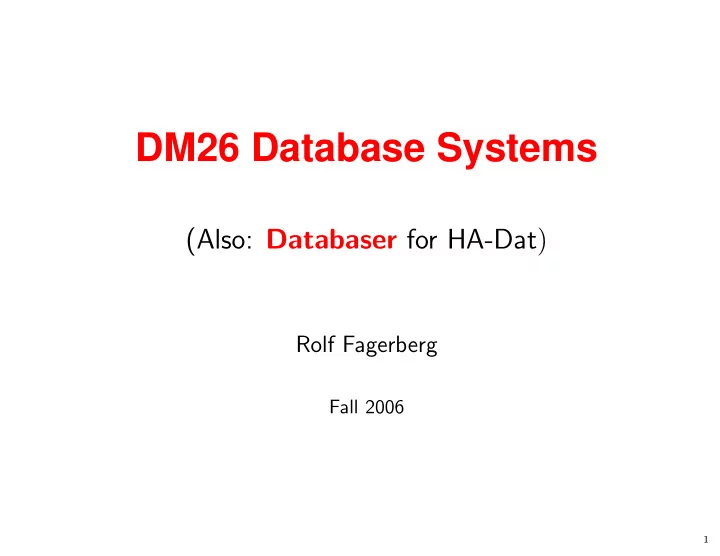

DM26 Database Systems (Also: Databaser for HA-Dat ) Rolf Fagerberg Fall 2006 1
Course Credit 7.5 ECTS (HA-Dat: 5 ECTS). Literature Database Management Systems , Ramakrishnan and Gehrke, 3rd edition. Exam Oral exam, 13-scale (HA-Dat: Project, 13-scale) Project Database design and implementation project (using PostgreSQL). Pass/Fail (except for HA-Dat). Hours Two lectures a week Two exercise lessons a week. 2
Need for Databases • Corporate data (payrolls, inventory, sales, customers, accounting, documents,. . . ) • Banking systems • Stock exchanges • Airline systems • University data (students, grades) • Hospitals • Scientific data • Website backends • Personal data (CD collection, addresses,. . . ) 3
Database Desiderata • Ease of use • Flexible searching • Efficiency • Centralized storage, multi-user access • Scalability (large amounts of data) • Security and consistency: – Concurrency issues – System crashes – Access control – Integrity constraints on data • Abstraction (implementation hiding) • Good data modeling 4
Current Systems • DBMS = DataBase Management System • Many vendors (Oracle, IBM DB2, MS SQL Server, MySQL, PostgreSQL,. . . ). • All rather similar. • Very big systems. Surprisingly easy to use. Common features: • Relational model • SQL as query language • Server-client architecture 5
History Early 60’s Integrated Data Store , General Electric. First general purpose DBMS. Network data model. Late 60’s Information Management System , IBM (still in use!) Hierarchical data model. 1970 E. Codd: Relational data model, relational query languages. 6
History (Cont.) Mid 70s First relational DBMSs (IBM System R, UC Berkeley Ingres, Oracle,. . . ). First version of SQL (SEQUEL) appears. 80s Almost all commercial systems now based on relational model. SQL standardized. 90s Additional features added to DBMS: richer data types (large objects, OO-features), tools for manament, report generation, business analysis, data mining. Object-oriented DBMS appear, but not dominant. 7
Why Study DBs? • Very widely used. • Part of many software solutions. • DB expertise is a career asset. • Interesting: – Mix of many different requirements – Mix of many different methodologies – Real world application Note: Real world applicability has top priority. Heuristics more than theory (few theorems). 8
DB People • End users (zillions) • Application programmers (billions) • DBMS administrators (millions) • DBMS suppliers (thousands) 9
DB development Phases: 1. Requirement specification (not covered here) 2. Data modeling (conceptual design) 3. Database modeling (logical database design) 4. Application programming (interface for end users) 5. Database tuning (physical database design) 10
Issues covered in course Part I: Developing DB applications • E/R-model for data modeling • Relational model (data model, relational query languages, normal forms) • SQL syntax • Application programming • DB tuning 11
Issues covered in course (Cont.) Part II: DBMS implementation principles • Physical data storage • Index structures • Query parsing, optimization, execution • Concurrency control (transactions) • Crash recovery Important background knowledge for efficient use of DBs, in particular for tuning. 12
Issues not covered in course The following database subjects are also interesting, but we have no room for them. Can be found in later chapters in the textbook. • Database access control • Distributed databases • Object-oriented databases • Deductive databases • Data warehousing • Spatial databases 13
Note • Database Systems Course � = SQL • Database Systems Course � = Oracle, IBM DB2, PostgreSQL,. . . Database Systems Course = principles of use and im- plementation of relational database systems. 14
Recommend
More recommend